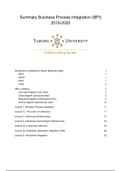Samenvatting
Summary Business Process Integration () - Tilburg university
This summary provides an extensive overview of the lecture material, computer classes, and lecture notes of BPI by Fransesco Lelli (2019). It elaborates on UML elements and includes lots of examples. Please leave a review ***** if the summary helped you studying :)
[Meer zien]





